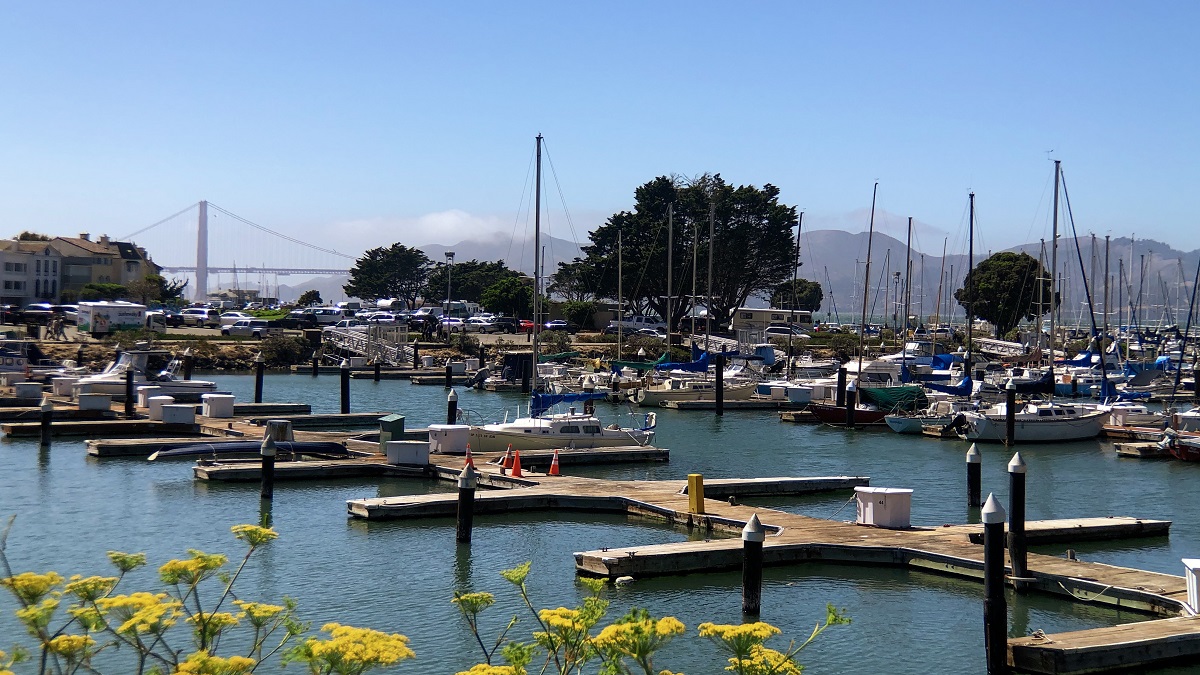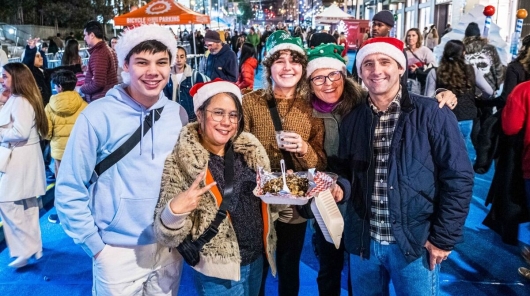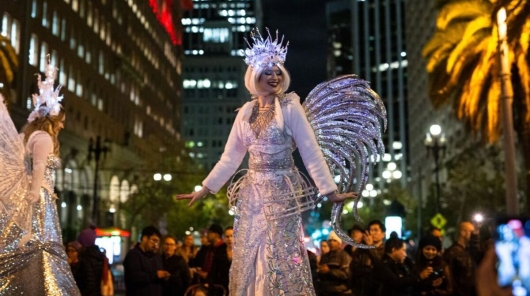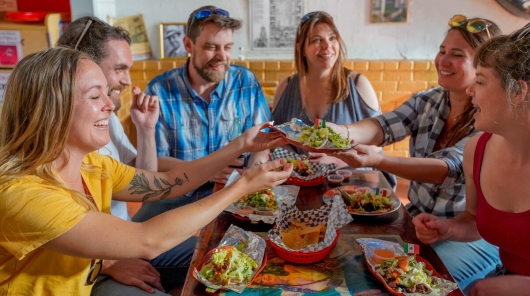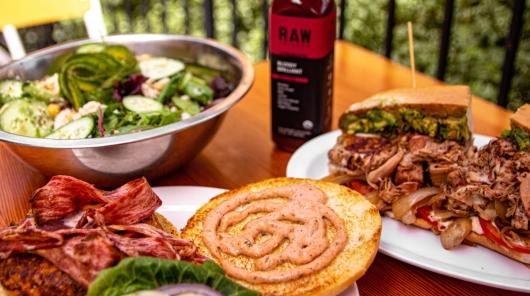Play tourist for a day in San Francisco on this BARTable walk from the Embarcadero to the Presidio and (re)visit famous city landmarks and discover hidden treasures among some of its most popular attractions along the way.
Walk Time: 3 hours | Distance: 6.5 miles | Terrain: Sidewalks, boardwalks, and paved trails
Exit the Embarcadero Station up to the street level using Exit 1A. Walk down Drumm Street away from the cable car turnaround and through the Embarcadero Center. At Washington Street, take a right and cross over to Pier 1. Head left and join the stream of locals and visitors en route to points all along the Embarcadero that stretches from Oracle Park in the south to Pier 45 ahead in Fishermen’s Wharf. Piers 1, 1½, 3 and 5 opened in 1918 for trade and transportation to the Central Valley, allowing the agriculture industry to flourish and spurring on the growth of California’s economy. Together, they now form the Central Embarcadero Piers Historic District.

For a quiet stretch, detour to the public promenade with vintage-style benches and lamp posts that meanders along the bayside of the Central Embarcadero Piers.
Ahead at Pier 15 is the wondrous
Exploratorium. The groundbreaking museum opened in 1969 and was founded by Frank Oppenheimer, a physicist, professor, high school teacher and, at one time, a cattle rancher. Aptly described as “a mad scientist's penny arcade, a scientific funhouse and an experimental laboratory all rolled into one,” the Exploratorium inspires visitors of all ages to explore the world through science, art and human perception. You can spend an entire day roaming its 330,000 square feet of space and not see all of the 650+ hands-on exhibits, but here are four
must-sees.
Sit in one of the Archimedes exhibit bronze disks and whisper secrets to a friend seated in the other one 80 feet away across the Exploratorium’s front plaza.
Continue up the Embarcadero passing
Pier 23 (a favorite stop for live music and seafood served with an incredible bay view) and Pier 27 (site of the 2013 America’s Cup Park). At Pier 39, take a right- away from the crowds- onto the boardwalk and go past the private yachts, commercial boats and water taxis docked at the marina. As you round the back, you’ll hear them before you see them: the world-famous
Sea Lions of Pier 39. They showed up after the 1989 Loma Prieta Earthquake, commandeering a group of docks and kicking out the marina tenants. In their new safe harbor, their numbers quickly grew to more than 300 and reached a record high of 1,701 in November 2009.
The Pier 39 Sea Lions’ boisterous nature and endearing antics have inked their spot on the lists of top things to see and do in San Francisco.
Follow the boardwalk back to the street sidewalk and turn right. Stick alongside the waterfront into Fishermen’s Wharf to the end of the Embarcadero at Pier 45 (home of the
SS Jeremiah O'Brien, a World War II Liberty ship). Just across Taylor Street in a warehouse space to the right, pop into the
Musée Mécanique and be transported back to the San Francisco of the early 1900s with its collection of 200+ coin-operated vintage arcade machines and mechanical musical instruments. Try your luck at an antique slot machine or measure how suave your smooth is at the Kiss-O-Meter. Old-timers will know the collection well from when it was on Ocean Beach at the Playland amusement park (1913-1972).
Laffing Sal, the famous automated character, still amuses (and spooks) visitors to the Musée Mécanique with her rollicking laughter.
Head outside and take a short detour to the right. Away from the hustle and bustle of the wharf, just a few hundred yards ahead solemnly stands the
Fishermen’s and Seamen’s Memorial Chapel. The simple wood-framed building was built between 1978 and 1981 with money and labor from Bay Area fishermen. On the walls of the small chapel are plaques with the names of more than 200 men and women who lost their lives at sea while hanging from the ceiling are flags and banners of various religions. If open, don’t miss a visit in for a moment of peace and contemplation.
The Fishermen’s and Seamen’s Memorial Chapel is the only place remaining in the Bay Area that holds the traditional Catholic Latin Mass (Sunday and Holydays, 10am).
To rejoin the action, double back and take a right onto Taylor Street then cross to the other side of Jefferson Street and head right. Remember, you’re a tourist today so go ahead and pick up some souvenirs or get that bowl of chowder then carry on into the
San Francisco Maritime National Historical Park. Part of the National Park Service, the park covers Pacific Coast maritime history with a group of historic ships, museum, research center and the Aquatic Park Cove. On the corner at Hyde Street in an old brick cannery warehouse is the Visitor Center. Outside, their sign gives you the OK to call the city “Frisco” – the old sailors did. Inside is a collection of interpretative displays and artifacts, including the French-made glass lens of the old Farallon Islands lighthouse.

The Waterfront exhibit in the SF Maritime National Historical Park Visitor Center walks through the history of the waterfront from the Ohlone people to the industrialization of the early 1900s.
Keep on through the park around to the Aquatic Park Pier gate and hang a left up the hill into Fort Mason. The former US Army post covers 1,200 acres, part of which was the private property of John C. Frémont, the American explorer, politician, soldier and first presidential candidate of the Republican Party. He put down just $42,000 for a 13.5-acre plot in the mid- 1850s. The land though was seized in 1863 by executive order of President Lincoln for the Civil War. From World War II on, the fort was the main point of embarkation for troops and cargo to the Pacific. Today, it’s part of the Golden Gate National Recreation Area and home to a mix of attractions from museums, art galleries and schools to parks, cafes and restaurants. There’s also a
hostel,
Friday food truck night and a
farmers’ market on Sundays.
If Karl the Fog has taken the day off, take in the spectacular view of the Golden Gate Bridge from atop the hill then continue down the paved path to the entrance of the fort’s lower port area at the intersection of Laguna Street and Marina Blvd.

In the lower port area of Fort Mason, take a break with an Equator Coffee or wash down some hearty Bavarian fare with a lager at Radhaus.
Make your way along the waterfront path, part of the
San Francisco Bay Trail, into the Marina District. Fall in with the parade of strollers and runners and check out the ultimate games and kite flyers (sometimes engaged in fierce battle!) on the Marina Green, which was once an airfield for the transcontinental airmail service. The neighborhood itself was built upon rubble from the 1906 San Francisco Earthquake and landfill dredged from the bay for the 1915 Panama-Pacific International Exposition. This foundation liquefied during the 1989 Loma Prieta Earthquake, leading to dozens of collapsed and damaged buildings and, tragically, four deaths.
Circle around past the harbor back to Marina Blvd. and cross over to Scott Street. Take a right onto Beach Street and walk a few blocks down to Baker Street and one of San Francisco’s most recognized landmarks, the
Palace of Fine Arts. Completed for the 1915 exposition, it was only meant to last for the duration of the event but was so loved that a preservation group was formed by Phoebe Apperson Hearst (mother of William Randolph Hearst) to save it from demolition. In 1964, the entire complex was reconstructed with permanent concrete and steel materials with a restoration and seismic retrofit in 2010.

The Palace of Fine Arts has had many interesting uses throughout its years – tennis court facility, military vehicle storage, limousine station for the United Nations are a few.
Head left onto Baker Street and then right onto Francisco Street. Cross Richardson Avenue and take a left onto Lyon Street then a right through the Lombard Gate into the
Presidio. As proclaimed on its web site, “The Presidio is where San Francisco began.” The land was home to the native Ohlone people for thousands of years before the Spanish established their military fort here in 1776. It moved under the control of Mexico after its independence from Spain in 1821 before passing to the United States in 1846 during the Mexican American War when it then became a US Army post. After the Army left in 1994, the prime real estate was almost sold at auction until it was transferred to the Presidio Trust (created by Congress in 1996) and the National Park Service.

Bring a blanket to the Presidio Picnic on the Main Parade Ground and grab bites from the 30+ international food vendors (Sundays from 11am to 4pm, March to October).
Just beyond the Lombard Gate, veer right off the sidewalk and take the path to its far end. There, if you’re a Star Wars fan, take a selfie with the legendary Yoda at his fountain outside the Lucasfilm lobby then follow the curb around to Letterman Drive and take a right. At Lincoln Blvd., cross over and walk down to Funston Avenue. Tucked away behind the Old Post Hospital on the corner (take the stairs on the left) are two preserved
1906 San Francisco Earthquake cottages. In the aftermath of the disaster, thousands fled the city leaving 250,000 homeless behind who sought shelter in make-do refugee camps and among the city ruins. The Army stepped in and organized formal tent camps, housing 16,000 refugees alone in the Presidio. For the approaching winter, the city constructed 5,300 of these “shacks” for those still in need.

Each earthquake cottage cost $50 and tenants paid $2 a month until paid up, after which, they were required to move it from the camps.
Continue on Funston Avenue and follow it to the right onto Moraga Avenue and step into the Presidio Officers’ Club. Considered “the Army’s best club,” the building’s history stretches all way back to the founding of the Presidio. The front Mesa and Anza rooms where you can see an exposed section of the adobe walls are the only standing structures left from the Spanish era. Through multi-media displays, the Presidio Heritage Gallery inside tells the story of the Presidio starting from 10,000 years ago as the home of the Ohlone through the Spanish, Mexican and American military eras to its present incarnation as a national park (Tuesday to Sunday, 10am to 5pm; free admission).

For more than a century, Army officers gathered in Moraga Hall for grand dances, banquets and balls. Now, you can also bask in the ambience of this “living room of San Francisco.”
To finish up the walk, exit the club and head down Graham Street towards the bay to the
Presidio Transit Center. That’s right – there is no “Presidio” BART Station, but there is the
PresidiGo Shuttle. Board the Downtown shuttle for a 20-minute ride back to the Embarcadero BART Station (get off at the California/Drumm stop). A shuttle leaves every half hour on weekends with varied departure times on weekdays. Check the
schedule. The service is free; however, it is pass-restricted during weekday commute hours.
Route Maps
Variations and options
-
-
Join a walking tour:
San Francisco City Guides offers a variety of tours in every one of the neighborhoods on this walk. Free (donations welcome) for groups up to 8.
-
What to bring: Sturdy walking shoes and a daypack with water, bag lunch or snacks (or pick up along the way), sun protection (hat, sunscreen), extra layers or rain gear (just in case). A smartphone is handy for maps and looking up information or taking photos. And, of course, your Clipper Card!
About the station
Embarcadero Station first opened in May 1976. It is the first San Francisco stop for trains crossing the bay from Oakland. With 48,569 average exits each weekday in 2019, it is the busiest station in the BART system, with Montgomery St Station close behind. However, the station was not part of the original concept for BART, being built three years after the other San Francisco stations. The redevelopment of the lower Market St area led to the addition of the station to the system.
